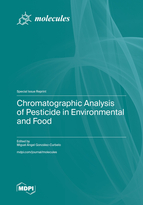Chromatographic Analysis of Pesticide in Environmental and Food
A special issue of Molecules (ISSN 1420-3049). This special issue belongs to the section "Analytical Chemistry".
Deadline for manuscript submissions: closed (31 October 2023) | Viewed by 32667
Special Issue Editor
Interests: multi-residue analysis; contaminants; environmental and food analysis; sample preparation; chromatographic techniques; mass spectrometry; analytical methods
Special Issue Information
Dear Colleagues,
Pesticides are still globally used in agriculture to control pests and increase crop yields. Due to their massive application, often without considering good agricultural practices, pesticides can be released into the environment and remain in foods as residues. Consequently, they can adversely affect non-target organisms and human health. In response, legal directives and monitoring programs have been established in most countries to manage the use of pesticides based on maximum permissible levels of their residues. Therefore, it is important to develop highly selective and sensitivity multi-residue analytical methods to determine these residues in complex matrices at the levels required by current legislation. This Special Issue specifically focuses on the determination of pesticide residues at trace levels in environmental and food matrices by chromatographic techniques combined with mass spectrometry or other suitable detectors, including the development and validation of analytical methods as well as monitoring studies.
Prof. Dr. Miguel Ángel González-Curbelo
Guest Editor
Manuscript Submission Information
Manuscripts should be submitted online at www.mdpi.com by registering and logging in to this website. Once you are registered, click here to go to the submission form. Manuscripts can be submitted until the deadline. All submissions that pass pre-check are peer-reviewed. Accepted papers will be published continuously in the journal (as soon as accepted) and will be listed together on the special issue website. Research articles, review articles as well as short communications are invited. For planned papers, a title and short abstract (about 100 words) can be sent to the Editorial Office for announcement on this website.
Submitted manuscripts should not have been published previously, nor be under consideration for publication elsewhere (except conference proceedings papers). All manuscripts are thoroughly refereed through a single-blind peer-review process. A guide for authors and other relevant information for submission of manuscripts is available on the Instructions for Authors page. Molecules is an international peer-reviewed open access semimonthly journal published by MDPI.
Please visit the Instructions for Authors page before submitting a manuscript. The Article Processing Charge (APC) for publication in this open access journal is 2700 CHF (Swiss Francs). Submitted papers should be well formatted and use good English. Authors may use MDPI's English editing service prior to publication or during author revisions.
Keywords
- pesticide residue analysis
- environmental and food analysis
- sample preparation
- chromatography
- mass spectrometry
- analytical method development and validation







